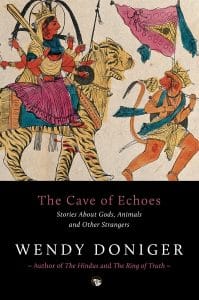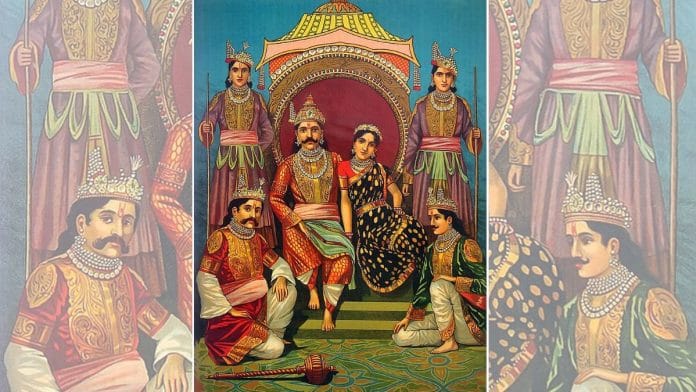The fluidity of the Indian oral/written tradition is in part merely one aspect of the more general fluidity of Indian attitudes to all kinds of truth. This fluidity was eloquently described by E. M. Forster in A Passage to India: “Nothing in India is identifiable; the mere asking of a question causes it to disappear or to merge into something else.” In his notes on this novel, Forster himself succumbs to this fluidity in discussing Adela’s accusation that Aziz had assaulted her in the cave:
In the cave it is either a man, or the supernatural, or an illusion. If I say, it becomes whatever the answer a different book. And even if I know! My writing mind is therefore a blur here. . . . I wouldn’t have attempted it in other countries, which though they contain mysteries or muddles, manage to draw rings around them.
And in response to the suggestion that “the hallucination was not Adela’s but Aziz’s . . . but it communicated itself to Adela” (a process which occurs often in Indian philosophical narratives), Forster remarked that “he had not thought of this explanation but that he liked it quite as well as any other.”
There is no Ur-text, for there is no Ur-reality. Like us, though more explicitly, Indians may maintain a belief in several different, contradictory answers to the same question; they alter their definitions of reality in order to let such contradictions survive. All truths being multiple, it is not surprising that the true version of any story is also multiple. Lévi-Strauss has argued that all variants of a myth—Freud’s Oedipus as well as Sophocles’ Oedipus—are part of the myth. It might be argued that not all variants are equally valid, but the basic maxim applies, I think, to our culture and even more dramatically to India.
In Sanskrit texts, the bard may recite a myth in a certain way, only to be interrupted by someone in the audience to whom the tale is being recited, who argues, “We heard it differently.” When the person in the audience tells that second version, the bard replies, “That is true, too, but your version happened in a different world era” —or, in some stories, “in a different rebirth.”
That is, the same event happens over and over again, but it may not happen in exactly the same way each time, and each happening is true. Moreover, what makes an event in India important is not that it happened at a particular time or place (which is what makes a historical event important in the West), but precisely the fact that it has multiplied, that it has happened many times in many places. Marx remarked that history repeats itself, and that the first time is tragedy, the second time farce. Myth repeats itself too, of course, but unlike history, it follows no evolutionary course; any of its countless retellings may be tragic or comic at random.
Also read: There’s no concept of despair in classical Indian philosophy and art
A wonderful example of the degree to which this sort of plurality is both a widely shared cultural assumption and a still debated open question is the manner in which the Jainas told the story of the end of the Mahabharata:
The great Jaina sage Hemachandra went about lecturing to great crowds, telling them, among other things, that the Pandavas, the heroes of the Mahabharata, had become Jaina monks at the end of their lives. Upon learning of this, the Brahmins of that city complained to the king, pointing out that in Vyasa’s Mahabharata, the Pandavas died in the Himalayas, after propitiating Shiva. “But these Jainas,” they continued, “who are actually Shudras [low-caste servants], since they have abandoned the true words of the Puranas [mythological texts], in their own assemblies babble things about the Pandavas which are contrary to the smritis.”
The king summoned Hemachandra and asked him, “Is it true that, according to the Scriptures, the Pandavas renounced the worlds according to Jaina rules [i.e., they became Jaina monks]?” The venerable acharya said, “This has been said by our ancient acharyas in our scriptures, and it is [equally] true that their sojourn in the Himalayas is described in the Mahabharata. But we do not know whether those [Pandavas] who are described in our scriptures are the same as those who are described in the work [Mahabharata] of the sage Vyasa, or yet by still other authors in different works.
“Indeed, there is a story told in Vyasa’s Mahabharata, that when Bhishma died, he wished to be cremated at a place where no one had ever been cremated before. His attendants took him to the top of the hill, but when they readied the body for cremation a divine voice spoke: ‘A hundred Bhishmas have been cremated here, and three hundred Pandavas, and a thousand Dronacharyas. As for Karnas [cremated here], their number is beyond counting.’ Knowledge can be obtained from any source. Like the River Ganges it cannot be claimed by anybody as his paternal property.”
When the king asked the Brahmins, “Is what the Jaina sage says true?” they remained silent, and the king praised the Jaina sage.
“Knowledge” —that is, a true story—“can be obtained from any source.” The Jaina sage wins on several counts. He outdoes the Brahmins by citing against them their own scripture, the Mahabharata.
Though the story that he cites is not in the extant Hindu critical edition—for whatever that is worth—, it is a variant on another, well-known Hindu story: Once when Indra, the king of the gods, was puffed up with pride, he made Vishvakarman, the architect of the gods, build him a palace, to be the grandest palace ever built. But Vishvakarman humbled Indra by showing him a parade of ants and pointing out that every one of those ants had, in a former life, been an Indra. The Jaina sage might also have had in mind a famous Buddhist parable, in which a woman whose son has died comes to the Buddha for consolation; he sends her to beg for a mustard seed from a house in which no one has died, and as she goes on this search, at first confidently and then with dawning awareness of its futility, she is humbled and consoled.
Thus Hemachandra reworks an old story to argue explicitly in favor of the reworking of old stories; and he maintains that even that story is not the only version of that event. The king, who keeps insisting on his duty to remain impartial, ends by praising the open-minded Jaina over the exclusivist Brahmins. The Jainas, moreover, have by their open-mindedness been able to assimilate into their own religion a great classic that belonged originally to another religion. This is a process that we might hope to emulate.
 This excerpt from Wendy Doniger’s ‘The Cave of Echoes: Stories About Gods, Animals, and Other Strangers’ has been published with permission from Speaking Tiger Books.
This excerpt from Wendy Doniger’s ‘The Cave of Echoes: Stories About Gods, Animals, and Other Strangers’ has been published with permission from Speaking Tiger Books.






